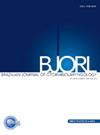非化脓性中耳手术后耳真菌病的风险。
IF 1.7
4区 医学
Q2 OTORHINOLARYNGOLOGY
引用次数: 0
摘要
目的:本研究的目的是探讨慢性非化脓性中耳炎(CNSOM)手术患者术后可能引起耳真菌病的危险因素。方法:在回顾性研究中,523例患者中有409例符合纳入标准。对44例确诊为CNSOM耳真菌病的患者进行分析。分析围手术期因素以确定耳真菌病的潜在危险。导致耳真菌病的主要因素是粘附性耳垢、鼓室-金属瓣定位和糖尿病。该研究分析了手术后6个月患者的随访情况。术后30天内发生的耳真菌病为“早期耳真菌病”,术后30天内发生的耳真菌病为“晚期耳真菌病”。结果:耳真菌病组和非耳真菌病组6个月移植成功率无显著差异。我们发现DM的存在、鼓室-金属瓣定位和牢固粘附的耵聍清除与耳真菌病的发展显著相关。logistic回归模型显著,解释了9.2%的变异。总体而言,存在先期皮瓣、DM和耵聍清除状态的个体患耳真菌病的可能性分别是2.0倍、2.8倍和2.1倍。糖尿病是所有三名发展为晚期耳真菌病的患者中唯一确定的危险因素。结论:本研究发现外耳道上皮完整性受损、非上皮区和血液循环减少是术后耳真菌病的独立危险因素。证据等级:4;本文章由计算机程序翻译,如有差异,请以英文原文为准。
Otomycosis risk after non-suppurative middle ear surgery
Objectives
The aim of this study was to investigate the risk factors that may cause postoperative otomycosis in patients undergoing Chronic Nonsuppurative Otitis Media (CNSOM) surgery.
Methods
In this retrospective study, 409 out of 523 patients met the inclusion criteria. 44 patients diagnosed with otomycosis CNSOM were analyzed. Perioperative factors were analyzed to determine the potential risks of otomycosis. The primary factors identified as contributing to otomycosis were firmly adherent cerumen, tympano-meatal flap positioning, and Diabetes Mellitus (DM). The study analyzed the patients’ follow-up six months after the surgical procedure. Otomycosis occurring within 30-days of surgery was classified as “early otomycosis”, while those occurring later were classified as “late otomycosis”.
Results
Graft success at 6-months showed no significant difference between otomycosis and non-otomycosis groups. We found that the presence of DM, tympano-meatal flap positioning, and firmly adhered cerumen removal were significantly associated with the development of otomycosis. The logistic regression model was significant and explained 9.2% of the variation. Overall, individuals with the presence of advancement flap, DM, and cerumen removal status were respectively 2.0, 2.8, and 2.1 times more likely to have otomycosis. DM was the only risk factor identified in all three patients who developed late otomycosis.
Conclusion
This study found that compromised epithelial integrity in the external auditory canal, non-epithelial areas, and reduced blood circulation were independent risk factors for postoperative otomycosis.
Level of evidence
4.
求助全文
通过发布文献求助,成功后即可免费获取论文全文。
去求助
来源期刊

Brazilian Journal of Otorhinolaryngology
OTORHINOLARYNGOLOGY-
CiteScore
3.00
自引率
0.00%
发文量
205
审稿时长
4-8 weeks
期刊介绍:
Brazilian Journal of Otorhinolaryngology publishes original contributions in otolaryngology and the associated areas (cranio-maxillo-facial surgery and phoniatrics). The aim of this journal is the national and international divulgation of the scientific production interesting to the otolaryngology, as well as the discussion, in editorials, of subjects of scientific, academic and professional relevance.
The Brazilian Journal of Otorhinolaryngology is born from the Revista Brasileira de Otorrinolaringologia, of which it is the English version, created and indexed by MEDLINE in 2005. It is the official scientific publication of the Brazilian Association of Otolaryngology and Cervicofacial Surgery. Its abbreviated title is Braz J Otorhinolaryngol., which should be used in bibliographies, footnotes and bibliographical references and strips.
 求助内容:
求助内容: 应助结果提醒方式:
应助结果提醒方式:


